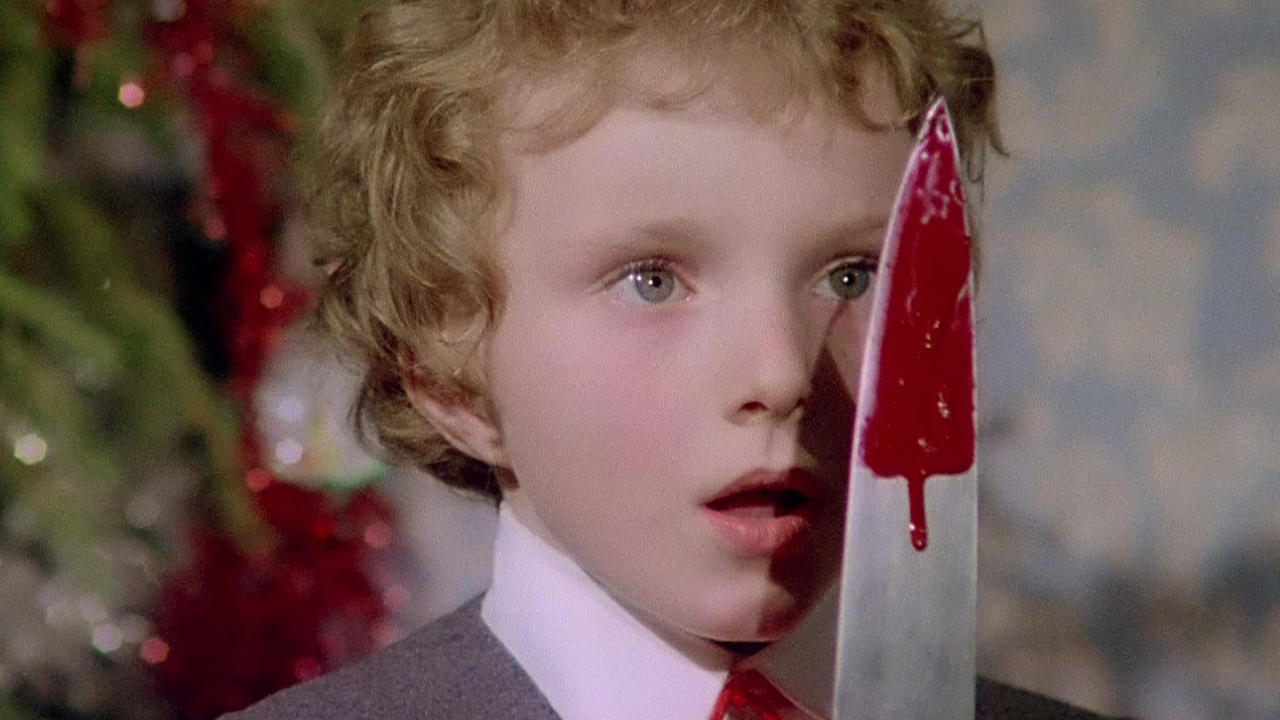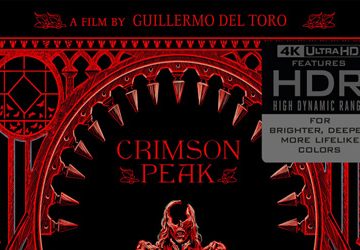Four years after the conclusion of his “Animal Trilogy” (The Bird With the Crystal Plumage 1970, The Cat O’Nine Tails 1971, and Four Flies on Grey Velvet 1971), Dario Argento returned with the feature film, Deep Red (AKA Profondo Rosso, The Hatchet Murders), starring David Hemmings (Blow up 1966, Barbarella 1968), Daria Nicolodi (Inferno 1980, Phenomena 1985), Gabriele Lavia (Beyond the Door 1974, Inferno 1980), and Clara Calamai (Obsessione 1943, Le Notte Bianche 1957), written by Dario Argento and Bernardino Zapponi (Writer: Fellini Satyricon 1969, Roma 1972), and directed by Dario Argento.
- Still from Deep Red
A child’s piercing scream… a shadow of someone getting stabbed repeatedly… a disturbing children’s song playing throughout it all. Marcus Daly (Hemmings), a professional pianist and professor at a music conservatory, is conducting a live Jazz session. He stops to compliment the band, but says they are playing too well and tells them that the sound is not trashy enough. The scene goes into a parapsychology conference where three people, Professor Giordani (Glauco Mauri: China is Near 1967, Macbeth 1975), Mrs. Helga Ulmann (Macha Meril: Bolero 1981, Deadly Circuit 1983), and Bardi (Piero Mazinghi: The Night Porter 1974, La Cage au Folle 1978), are giving a lecture on psychic ability. Mrs. Ulmann’s demonstrations her ability to read thoughts and gives an accurate reading of a random member of the audience. She then receives terrifying visions and says that there is a “twisted mind in the room.” She points to the audience and says, “You have killed and you will kill again.”
An unseen person quickly leaves the room and goes into the restroom to rinse their face at the sink. The person looks into the mirror, but it is badly tarnished and casts virtually no reflection. Back in the auditorium, Mrs. Ulmann is walking with Prof. Giordani and reveals that she knows who the killer is, but does not realize she is being watched from the shadows. As she receives another vision, she disregards it as residue from when the killer had been there previously. Later at Mrs. Ulmann’s apartment, she is talking on the phone about an article being published when suddenly the unnerving child’s song begins to play from all around her. As it quickly stops, her doorbell rings so she hangs up the phone and answers the door. Before she can grab the knob, she receives another vision and screams. The door bursts open and Mrs. Ulmann is viciously attacked with a meat cleaver.
At the same time, Marcus is walking to a bar to meet his friend Carlo (Lavia), who is drunk and sitting on the ground near a fountain. After a brief exchange of philosophies, they both start walking to the bar across the street when a piercing scream fills the wide open space. Marcus sees the bloody Mrs. Ulmann at the window as her killer hits her one more time with the cleaver. Her head goes through the window and impales her neck on the glass. Mark runs into the apartment, down the hall and notices paintings of strange faces. He finds Mrs. Ulmann’s body, pulls her off of the glas, and sees a suspicious character walking away from the building. Not long after, the police arrive and question him, which leads the detective to make fun of Marcus for his career choice as a pianist. All of a sudden, Gianna Brezzi (Nicolodi) bursts into the scene and begins snapping photos. One of the detectives tries to get her out, but her tenacity will not be denied. The detectives ask her a few questions about Mrs. Ulmann and, as she is about to leave, she snaps a quick photo of Marcus before he himself is taken in for questioning. A few hours later, Marcus is released and talking to Carlo, who’s even drunker than before, in the same spot near the fountain. Marcus insists he saw a peculiar painting that disappeared after the police got there and Carlo infers that it might be important.
- Still from Deep Red
The next day at Mrs. Ulmann’s funeral, Marcus and Gianna are standing in the back and she gives him information regarding Girodani and Bardi. As they are walking afterwards, he sarcastically thanks her and shows her the front page of the paper naming him the only eyewitness. Gianna shamelessly begins hitting on Marcus, telling him she has no boyfriend and invites him back to her place, but he declines. Later at Carlo’s apartment, Marcus is greeted by Carlo’s eccentric Mother, Marta (Calamai) but Carlo is not home so she gives him the address of where he is at the moment. When Marcus arrives, he is greeted by Massimo Ricci (Geraldine Hooper: They Have Changed Their Face 1971, Emmanuelle in Soho 1981), a transvestite, and discovers that Carlo is homosexual. Drunk yet again, Carlo admits he drinks to dull his self-loathing ways. As they are walking together, Carlo begs Marcus to just end the investigation, but Mark says it is now an obsession. Little does Mark know what dark path his new obsession will take him.
Deep Red was shot almost entirely in and around Turin, Italy. Argento has been reported as saying this was due to the large number of practicing Satanists in Europe, and it gave the city a kind of magical essence. The story for Deep Red came about when Dario Argento approached co-writer Bernardino Zapponi with nothing more than the parapsychology conference scene. They collaborated from there and the death scenes in particular were written based on their relatability to the audience. For example, almost everyone has been burned to some extant by boiling water, even if only a spatter from a pot. In Deep Red, Argento and Zapponi took that one step further when the character of Amanda Righetti (Giuliana Calandra: Love and Anarchy 1973, The Last Woman 1976) is dunked repeatedly in scalding hot bath water until her face is covered in blisters. This is a scene that has been imitated several times and taken even further in films like Halloween II (1981) and My Bloody Valentine (1981). Another example is the death scene of Giordani. His mouth and head are bashed on the corners of various solid objects, such as the fireplace mantle and table, repeatedly. Everyone has hit a part of their body on the corner of furniture at some point.
- Still from Deep Red
The characters are all cohesive and believable. The chemistry between Mark and Giovanna is palpable, even if a little hammy, and mist of the lighthearted scenes are between the two characters. For example, their debate on who is the stronger sex is humorous as it results in an arm-wrestling match, which Giovanna won twice. The character of Carlo is nothing short of tragic. Not only did he witness the murder of his own loving father at the hands of his psychotic mother, but he was forced to help cover it up and repress the memory. Later in life, he is unable to cope with his sexual orientation, so he hides behind his piano playing and excessive drinking. In the end, he just wants to protect his mother, but is killed in a vicious manner. Referred by Bernardino, this was the first project that Nicolodi worked on with Argento. Not long after, the two became a couple and soon married. They collaborated on several films together and had a daughter named Asia. Unfortunately, it was a fast burning relationship that was not built to last.
Originally, the score for Deep Red was composed by Jazz pianist, Giorgio Gaslini (Composer: La Notte 1961, Kleinhoff Hotel 1977). Although it was not the sound Argento was looking for, three of his compositions remain in the finished film. One day at the musical conservatory, he discovered a group of four men playing music that he really enjoyed and hired them on. The group of men turned out to be Progressive Rock band Goblin (Score: Dawn of the Dead 1978, Contamination 1980). Since then, they have collaborated on many projects.
One of the main themes in Deep Red concerns keeping a horrible secret for many years and how it could affect someone. However, the biggest theme is men versus women. All but one of the killer’s victims are women, so Marcus, being an arrogant chauvinist, assumes that only a man is capable of these heinous atrocities. He believed that a woman would lacked the strength to kill the victims. However, when he comes face to face with the killer, his philosophy on women being weaker sex drastically changes.
- Still from Deep Red
Similar to many Horror films of the time, Deep Red suffered a multitude of edits. Theatrically, it was released with a 126 minute run time in Italy, but for the U.S., it was cut down to 98 minutes and re-titled, The Hatchet Murders. Aside from some of the more graphic violence, all of Mark and Gianna’s romantic scenes were removed based on a decision made by Dario Argento himself. It is not often that a director censors their own work in that way. In 1999, Anchor Bay obtained the rights and released a version of the film with all scenes restored, however the restored scenes were not dubbed in English. Due to this, the DVD flows from English dubbed to English subtitled and back to English dubbed again. Some may find it difficult to watch, but in the end it is worth it to see the complete film. Another odd tidbit is after the international success of Suspiria (1977), Deep Red was released in in Japan as Suspiria 2 even though it has no connection to Suspiria and was made two years prior.
Even after forty years, Deep Red still manages to captivate and shock audiences with its brutal murders surprising twist ending. It is easy to see why this movie received such critical acclaim and became a commercial success. Deep Red showcased the techniques that Argento fans have comes to appreciate and love so dearly.
- Rizzoli Film










No comment